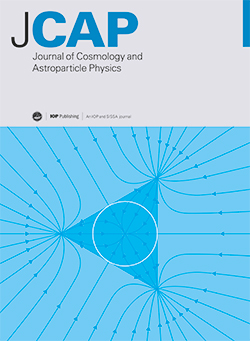正向约束下的霍恩德斯基引力现象学
IF 5.9
2区 物理与天体物理
Q1 ASTRONOMY & ASTROPHYSICS
Journal of Cosmology and Astroparticle Physics
Pub Date : 2024-08-22
DOI:10.1088/1475-7516/2024/08/029
引用次数: 0
摘要
任何有效场论都需要满足一系列条件才能获得可行的紫外完备性,这些条件最近在宇宙学背景下以实在性边界的名义获得了关注。在本文中,我们重温了霍恩德斯基引力的这种边界的推导,强调了将传统方法应用于宇宙学背景下的引力理论所带来的局限性。然后,我们用暗能量有效场理论的语言将这些边界转化为一套完整的可行性条件。我们在 EFTCAMB 中实现了后者,并探索了霍恩德斯基引力在实在性约束下的大尺度结构现象学。我们建立了一个具有统计意义的可行霍恩德斯基模型样本,并以 wDE 的形式推导出了相应的背景演化预测,以分别与聚类和弱透镜相关的现象学函数 μ 和 Σ 的形式推导出了线性扰动的动力学预测。我们发现,在传统的 "无幽灵 "和 "无梯度 "条件之外增加正向约束,可以大大加强对所有这些函数的理论约束。最重要的特征是加强了相关性 μ ≃ Σ,以及对引力波腔速 c2T ≃ 1 的相关严格约束。在这项工作中,我们展示了正向约束在塑造标量张量理论可行参数空间方面的强大潜力。这无疑是大有可为的,但同时也凸显了克服所有问题的重要性,这些问题仍然困扰着宇宙学背景下正向约束的严格表述。本文章由计算机程序翻译,如有差异,请以英文原文为准。
Phenomenology of Horndeski gravity under positivity bounds
A set of conditions that any effective field theory needs to satisfy in order to allow for the existence of a viable UV completion, has recently gained attention in the cosmological context under the name of positivity bounds. In this paper we revisit the derivation of such bounds for Horndeski gravity, highlighting the limitations that come from applying the traditional methodology to a theory of gravity on a cosmological background. We then translate these bounds into a complete set of viability conditions in the language of effective field theory of dark energy. We implement the latter into EFTCAMB and explore the large scale structure phenomenology of Horndeski gravity under positivity bounds. We build a statistically significant sample of viable Horndeski models, and derive the corresponding predictions for the background evolution, in terms of wDE, and the dynamics of linear perturbations, in terms of the phenomenological functions μ and Σ, associated to clustering and weak lensing, respectively. We find that the addition of positivity bounds to the traditional no-ghost and no-gradient conditions considerably tightens the theoretical constraints on all these functions. The most significant feature is a strengthening of the correlation μ ≃ Σ, and a related tight constraint on the luminal speed of gravitational waves c2T ≃ 1. In this work we demonstrate the strong potential of positivity bounds in shaping the viable parameter space of scalar-tensor theories. This is certainly promising, but it also highlights the importance of overcoming all issues that still plague a rigorous formulation of the positivity bounds in the cosmological context.
求助全文
通过发布文献求助,成功后即可免费获取论文全文。
去求助
来源期刊

Journal of Cosmology and Astroparticle Physics
地学天文-天文与天体物理
CiteScore
10.20
自引率
23.40%
发文量
632
审稿时长
1 months
期刊介绍:
Journal of Cosmology and Astroparticle Physics (JCAP) encompasses theoretical, observational and experimental areas as well as computation and simulation. The journal covers the latest developments in the theory of all fundamental interactions and their cosmological implications (e.g. M-theory and cosmology, brane cosmology). JCAP''s coverage also includes topics such as formation, dynamics and clustering of galaxies, pre-galactic star formation, x-ray astronomy, radio astronomy, gravitational lensing, active galactic nuclei, intergalactic and interstellar matter.
 求助内容:
求助内容: 应助结果提醒方式:
应助结果提醒方式:


